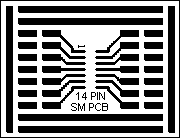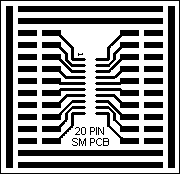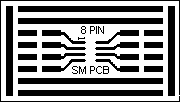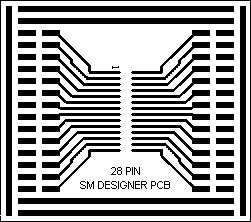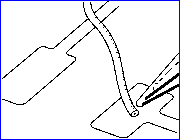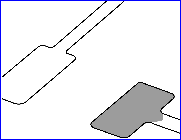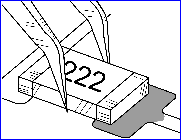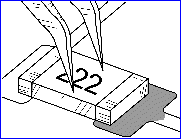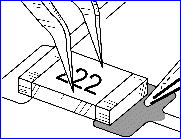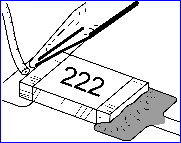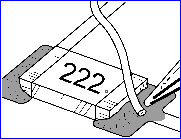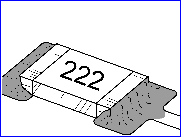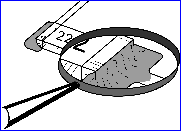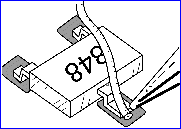|

ALL
ABOUT SM
All about Surface Mount components . . . SM transistor database,
soldering
and testing.
Buying SM transistors, capacitors, resistors, diodes and SM Prototyping
PC boards . . .
-by Colin Mitchell
|
|
Click
HERE for
SURFACE-MOUNT
Marking Code-to-Transistor
List 1 Philips
only
|
Click
HERE for
SURFACE-MOUNT
Marking Code-to-Transistor
List 2 Philips
& others
|
|
Click
HERE for
SURFACE-MOUNT
Transistor-to-Marking Code
Reverse of List 1
above
|
Click
HERE to buy SURFACE MOUNT packs.

DESIGNING WITH SM
It all depends on the type of circuit you are going to design, but if you want
the final result to look really professional and up-to-date, I recommend using SURFACE
MOUNT technology.
You don't have to make the whole project SM. You can combine SM with
through-hole components, as some items are not available (or not suitable) in SM
form. You may want to use chips that can be inserted and removed (such as
microcontroller chips) or air spaced coils (for high frequency oscillators) or a
potentiometer with a knob.
Even a combination of components looks very neat and if you buy your components
from Talking Electronics, you can produce very low-cost prototypes.
When it comes to production costs, SM becomes the cheaper alternative when very
large quantities are ordered.
In the meantime, you can start with TE surface-mount prototyping boards and
develop your skills in this area.
The following SM prototyping boards are available and these are mainly designed
for SM IC's. See below for PC board prices. You simply cannot design a circuit around
a chip that only comes in surface-mount, without a designer board. The pin
spacing does not fit any other prototyping boards and you cannot solder to the
pins without placing the chip on a board.
Some chips come in both surface-mount and standard pin spacing. You have to be
careful, sometimes the surface-mount variety behaves differently. We found this
to be the case with the CD 40106 Schmitt trigger IC.
There are 5 boards in the set: 8 pin, 14 pin, 16 pin, 20 pin & 28
pin
- only 4 boards are shown:
(the
boards are considerably smaller than
shown here - the pin spacing is 20 pins per inch for DIL TYPES! The normal
spacing is 10 pins
per inch.)
Standard components can be placed around the SM chip and all the parts are
placed on the track-side of the board. This saves turning the board over during
development.
The layout is called "birds nest" or "rats nest" and
although it doesn't look tidy, it's the only way to experiment as each item can
be fitted, removed and tested without turning the board over and losing your
concentration.
Once you get the circuit working you can tidy up the layout and reduce the size
of the board.
When it comes to SM, the board is considerably smaller than a conventional
design and it is cheaper to produce as it does not require
drilling. The 28 pin board can take an 8 pin and 14 or 16 pin.
When loading the boards by hand, SM assembly time is about the same as
conventional assembly and most of our assemblers prefer SM as they can line-up
20 to 50 boards and fit one component at a time with tweezers, without having to
turn the boards over.
Once you master the 3-Step process of soldering SM, you will want to
design everything in this medium.
SOLDERING SM
To solder SM, you need three items.
1. A very fine-tipped soldering iron with adjustable temperature.
2. A set of fine tweezers.
3. Fine solder - and I mean really fine solder!
You may also need a magnifying glass (magnifying lamp) to help with placement,
soldering and inspection.
IDENTIFYING SM RESISTORS
All SM resistors conform to a 3-digit code: (See 4-digit code below) 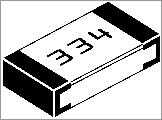
A 330k SM resistor
The first two digits represent the two digits in the answer. The third digit
represents the number of zero's you must place after the two digits. The answer
will be OHMS. For example: 334 is written 33 0 000. This is written 330,000
ohms. The
comma can be replaced by the letter "k". The final answer is: 330k.
222 = 22 00 = 2,200 = 2k2
473 = 47 000 = 47,000 = 47k
105 = 10 00000 = 1,000,000 = 1M = one million ohms
There is one trick you have to remember. Resistances less than 100 ohms are
written: 100, 220, 470. These are 10 and NO zero's = 10 ohms = 10R
or 22 and no zero's = 22R or 47 and no zero's = 47R. Sometimes the
resistor is marked: 10, 22 and 47 to prevent a mistake. (This is also done on
ceramic capacitors - not SM caps)
THE COMPLETE RANGE OF SM
RESISTOR
MARKINGS
Click to see the complete range of SM resistor markings for 3-digit code:
Click to see the complete range of SM resistor markings for 4-digit code:
SM CAPACITORS
Most SM capacitors are not identified in any way and the SIZE OF THE
COMPONENTS DOES
NOT indicate the capacitance as each capacitor has a different number of
layers. A 22n can be smaller than 1n due to the layers and the voltage
rating. There is also a number of different sizes for SM capacitors.
The only way to "read" the value is via a capacitance meter. Always
keep chip capacitors in their "carrier" until required.
Some manufacturers have a 3 digit code such as a letter to indicate the origin
of the component, a letter to represent the two digits in the capacitance (A=10,
B=12 C=15 D=18 etc) and the third digit is the multiplier. The answer is given
in pF (puff).
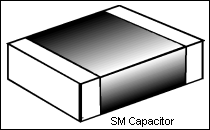
SM TANTALUMS AND ELECTROLYTICS
SM tantalums are marked in "n" "n" means nanofarad. (One
thousand nanofarad = 1 microfarad.)
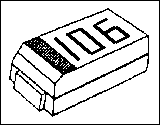
A 10u tantalum. The black line indicates the positive
end.
A simple way to to remember nanofarad is via the following:
0.001u = 1n Therefore: 0.01u = 10n and 0.1u =
100n (this is needed when you are dealing with standard ceramic capacitors)
105 = 1u = 1 microfarad
106 = 10u
107 = 100u
Here is the list of tantalum values: Tantalums come in 16v, 35v and 63v
105 = 1u
225 = 2u2
475 = 4u7
106 = 10u
226 = 22u
476 = 47u
107 = 100u
227 = 220u
Electrolytics are marked in the conventional way:
1/16 = 1u 16 volt working
22/25 = 22u 25 volt working
100/6 = 100u 6 volt working
SOLDERING SURFACE MOUNT
COMPONENTS:
SPEED
Speed is the essence when soldering surface-mount
components especially semiconductors. All SM components will withstand immersion
in hot solder for 10 seconds but this is because the solder is kept at the
lowest temperature possible. Most soldering irons are much hotter than this and
so your soldering time must be kept as short as possible.
After a small amount of practice, you will find SM assembly the smartest way to
go and many Talking Electronics projects are partially or fully surface
mount.
TESTING SM TRANSISTORS
Surface-Mount transistors are tested in exactly the same way as conventional
transistors - except their small size makes them physically more difficult to
test.
Click
HERE for our page on testing conventional transistors.
Here are some additional notes for surface mount types:
All surface mount transistor cases (styles) are the same - as shown below - and
have the same pin-out. The only difference is the size. This makes working with
them easy. The pin-out corresponds exactly to the NPN circuit-symbol. Each lead
is in the same relative position.

Note: The black lead of the multimeter is connected to the positive of the
battery via the movement (the meter inside the multimeter is called the
movement) and this is why the pointer produces the readings shown in
our animations. The diagram below shows the actual test circuit: 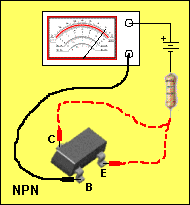
The circuit inside the multimeter
Most of the surface mount transistors you will be testing will be IN CIRCUIT.
This means you will (may) have to use our DUAL TEST approach. This involves
using the multimeter on high-ohms for the first test then low-ohms.
STEP ONE: Test the transistor on high-ohms as shown in the animation
below. All readings will be HIGH except for the reading between base and
collector when the black lead is on the base and between base and emitter
with the black lead on the base. This is shown in the animation below:
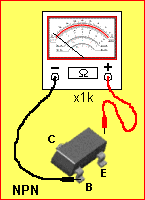
All readings will be high except the two above
The animation below shows a LOW reading between the collector and emitter
when the transistor is IN CIRCUIT. This may be a faulty transistor OR the
surrounding components creating the low resistance.
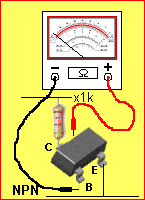
The low reading may be the transistor or a circuit
component
STEP TWO: Switch to LOW OHMS and retest the transistor. If the needle DOES NOT
swing 100% across the scale, the transistor is ok. This is shown in the
animation below:
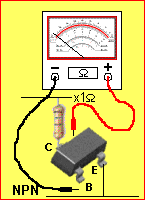
The multimeter on LOW-OHMS detects if the transistor
is OK.
SURFACE MOUNT COMPONENTS
Talking Electronics has packs of components available for the hobbyist and
repairman. The following packs are available:
SURFACE MOUNT RESISTOR PACK consists of 1 off each standard value
10 ohms to 1M & 2M2 (60 resistors)
A$14.20 US$8.00 including pack and post
SURFACE MOUNT CAPACITOR PACK
consists of:
2 - 10p 5 - 47p 5 - 100p 5 - 470p 5 - 1n
5 - 10n 5 -
22n 5 - 100n
5 - 1u 16v electrolytic 5 - 10u 16v electrolytic
5
- 10u 25v electrolytic 5 - 47u 16v electrolytic
(60 components)
A$23.80
US$12.00 including
pack and post
SURFACE MOUNT DIODE PACK consists of:
5 - 1N 4148 (marked as "A6")
A$10.00 US$5.00 including pack and post
SURFACE MOUNT TRANSISTOR PACK consists of:
5 - BC 848 (marked as "1K")
A$10.00 US$5.00 including pack and post
SURFACE MOUNT PC BOARDS:
A pack of 5 different surface mount PC boards for prototyping.
These are specially designed to take surface-mount IC's and the surrounding
components are conventional devices.
A$9.15 US$4.70 including pack and post SURFACE MOUNT
SOLDERING KIT:
This kit is designed to teach surface-mount soldering skills. It is a do-nothing
soldering kit containing: 5 resistors, 5 capacitors,
5 electrolytics, an 8 pin IC, 14 pin IC, a length of fine (0.71mm) solder
and a 28 pin SM PC board or 8 and: 14, 16 or 20 pin PC board.
A$14.50 US$8.00 including pack and post
Click
HERE for quick order form.

|
